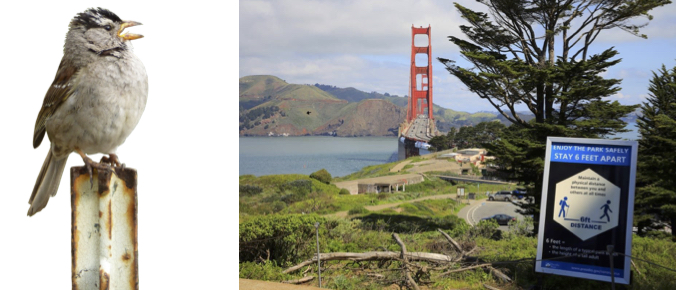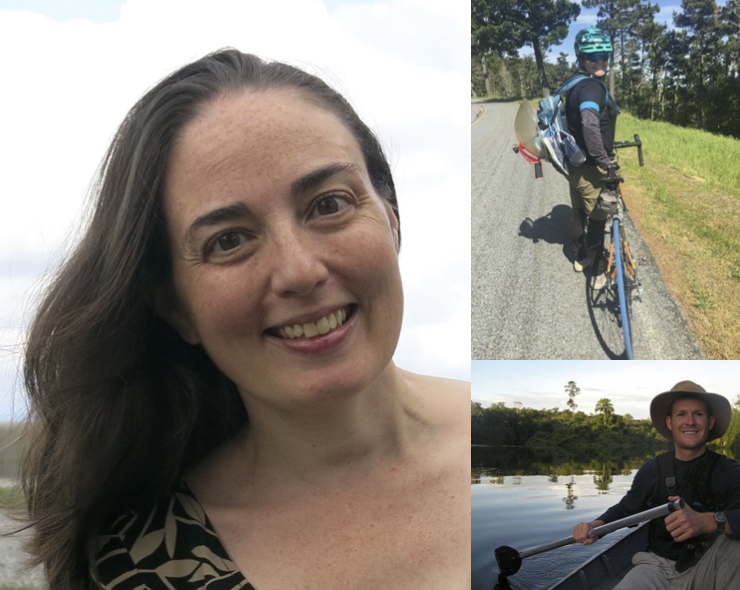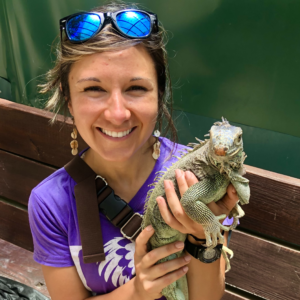Written by Jackie Childers
In early March of 2020 the world drastically changed with the outbreak of COVID-19. As countries abroad enacted travel bans and U.S. states issued local stay-at-home orders, suddenly the freedom of movement came to a grinding halt and everyone was forced to stay inside and shut their doors. Not everything, however, stopped moving. Within weeks images began to appear of dolphins swimming in the canals of Istanbul, boars wandering the streets of Israel, and of coyotes crossing the Golden Gate Bridge. While most of us marveled at these amazing, somewhat dystopian, images of wildlife reinvading the urban streets and corridors of our cities and towns, one scientist had a different epiphany.
Shortly after the lockdown began Dr. Derryberry called upon her colleague Dr. Jennifer Phillips, “We should go record!”. So out set Dr. Phillips who, with a field recorder and sound meter in hand, rode a bike to each field site, collecting an amount of data in three weeks in what it takes most field teams to collect in months. “I could definitely hear them better, because no one was out there. It was almost eerie, it just so starkly different.” stated Dr. Phillips, who would upload her data remotely so that on the other side of the country, co-author and sound engineer Graham Derryberry could process her recordings in a home studio.

In many ways their findings reaffirm what so many of us felt when we saw images of wildlife reacting to our sudden departure from the environment, that for better or for worse, our activities as humans clearly have a significant impact on our surrounding ecosystems and on the behavior of the animals that reside in them. This research also highlights why field studies are so important in an ever-changing world, “This just goes to show that long term studies really matter, because while it’s true that we were in the right place in the right time, none of the data we collected would be significant without the previous work we did” states Dr. Derryberry. Given their findings, the team is returning to the field sites this March to see how the birds are responding as traffic levels return to their pre-pandemic levels to ask: will this year’s cohort of males sing the songs that they learned from the adults that sang during the 2020 pandemic, or will they adapt their songs to their current environmental soundscape? “I think they’re going to sound like 2020, but David completely disagrees with me, he thinks they’ll respond with immediate flexibility” states Dr. Derryberry with a jovial laugh.
With a pandemic year that has been defined so much by loss, Dr. Phillips thinks that singing white-crowns offer a melody of hope, “I think that was the upside of the shutdown, people had more peace and quiet and time to wander around their neighborhoods and notice their wildlife. Maybe as we move forward we can apply this experience to the future as we continue to build up and develop our cities, since humans aren’t going anywhere, and the birds have shown that they will respond quickly and positively to any changes we do to improve the environment.”
Original article published in the 2020 October issue of Science.
All images courtesy of Dr. Elizabeth Derryberry.
About the Author
 Jackie Childers is a PhD candidate at the University of California-Berkeley where she conducts research in the fields of evolutionary biology, ecology and phylogenetic systematics. Her work chiefly focuses on African birds and lizards, especially from Namibia and South Africa where she has carried out fieldwork over the past decade.. Her current dissertation research seeks to understand the evolution of elaborate nest design in Weavers, a diverse family of songbirds whose members construct some of the most impressive and dazzling nests in the animal kingdom. To find out more about her work and on-going research projects, you can check out her website!
Email address: jchilders@berkeley.edu
Jackie Childers is a PhD candidate at the University of California-Berkeley where she conducts research in the fields of evolutionary biology, ecology and phylogenetic systematics. Her work chiefly focuses on African birds and lizards, especially from Namibia and South Africa where she has carried out fieldwork over the past decade.. Her current dissertation research seeks to understand the evolution of elaborate nest design in Weavers, a diverse family of songbirds whose members construct some of the most impressive and dazzling nests in the animal kingdom. To find out more about her work and on-going research projects, you can check out her website!
Email address: jchilders@berkeley.edu 
